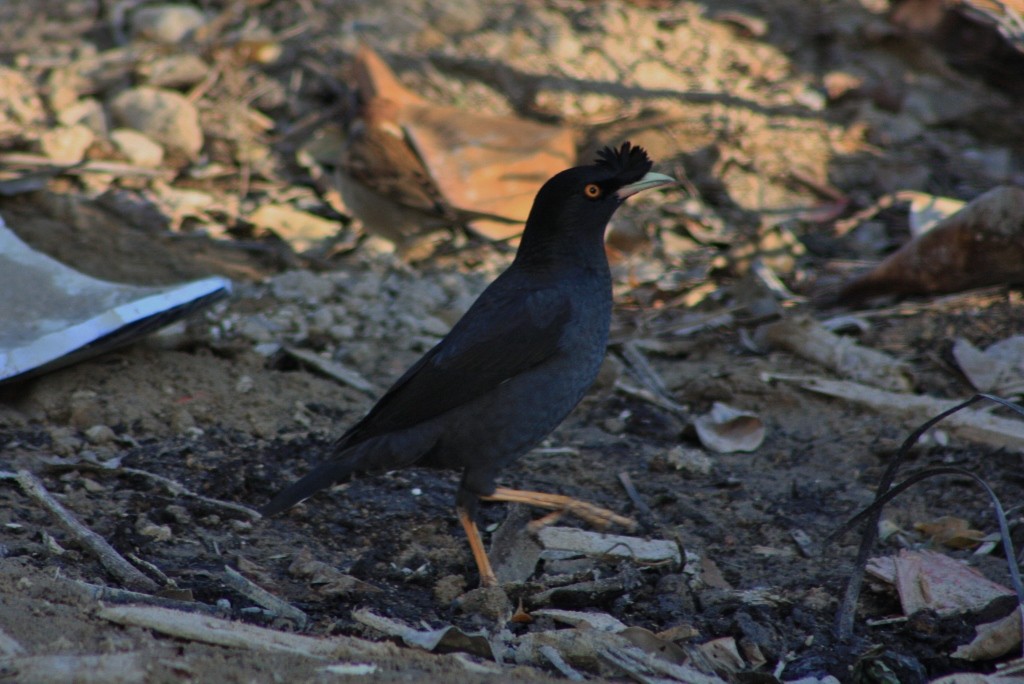Crested Myna
A species of Typical mynas Scientific name : Acridotheres cristatellus Genus : Typical mynas
Crested Myna, A species of Typical mynas
Botanical name: Acridotheres cristatellus
Genus: Typical mynas
Content
Description People often ask General Info
Description
The crested myna is named after the tuft of feathers that form a crest-like structure on its forehead that covers the bird's nostrils. It is mostly black with a slight green sheen. It has a couple of white wing patches under its wings which are more visible during flight. The tips and the base of the primaries are white. The tail feathers also have white tips with the exception of the middle pair. The under-tail coverts are black with a white tip. The adult's eyes are orange, its bill is pale yellow, and its legs are a dull dark yellow. Its bill is slender and very sharp. The males are slightly larger than the females. The female's crest is slightly less well developed. Otherwise, there is no sexual dimorphism. The hatchlings are born naked except for of a short gray down found on certain parts of the bird. In about 18 to 20 days, the juveniles become fully covered with brown feathers. The crest is usually not well developed at this stage. Immature crested mynas have blue-gray eyes. 
Size
25 cm (10 in)
Life Expectancy
11 years
Nest Placement
Tree
Feeding Habits
Crested Myna is omnivorous, primarily consuming insects, fruits, grains, and even garbage. With a diet fluctuating seasonally, adults have a 40% meat (notably flies) and 60% vegetation mix, leaning more towards meat in September. Juveniles favor a 75% animal-based diet. Crested Myna adjusts its feeding behavior to resource availability.
Habitat
Crested Myna thrives in versatile environments, from urban areas with structures like buildings and parks to rural settings, including agricultural fields and orchards. They favor lowland regions such as grasslands, forest edges, and cultivated lands like rice paddies, avoiding dense woodlands. Communal roosting is typical, often on structures such as telephone wires and trees.
Dite type
Omnivorous
People often ask
General Info
Feeding Habits
Bird food type
Distribution Area
The crested myna's range spans from southeastern and central China to northern Indochina. It is found in the Yangtze valley and the southeastern Jiangxi Province in China. The crested myna has also been recorded in Burma, Taiwan and Hainan. As a popular cage-bird, it is often transported outside of its normal range and, on occasion, can be accidentally released and introduced in a new area. For example, in the late 1800s, it was introduced to Vancouver, British Columbia. It was able to proliferate and its population grew to around 20,000 to 30,000 individuals. It could be found anywhere from the south of the province to Washington and Oregon. By the mid-twentieth century, numbers began declining, and the bird is now extirpated in North America. Other examples of the crested myna's introduction can be seen in Portugal. The bird was discovered breeding around Lisbon, Portugal in 1997. They are now established on both sides of the Tagus estuary to the west of Lisbon and also on the Setúbal Peninsula. The crested myna has also been successfully introduced in Penang, Singapore, Manila, as well as parts of Japan and Argentina. 
Species Status
Since 1998, the crested myna has been rated as a species of Least Concern on the IUCN Red List of Endangered Species. It has a range that is larger than 20,000 km and therefore, its range is too large for this bird to be considered vulnerable under the criterion of range size. Also, the population trends seem to be stable (over the last ten years or three generations) and so, this bird cannot be considered vulnerable under the criterion of population trends. Finally, it is believed that the population size exceeds 10,000 mature individuals and therefore its this bird cannot be considered vulnerable under the criterion of population size. 
Scientific Classification
Phylum
Chordates Class
Birds Order
Perching birds Family
Starlings Genus
Typical mynas Species
Crested Myna 